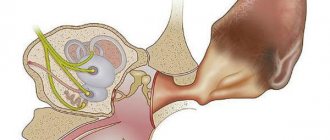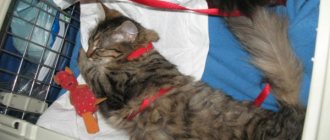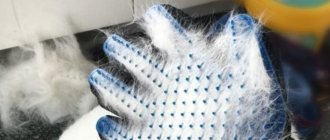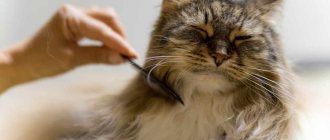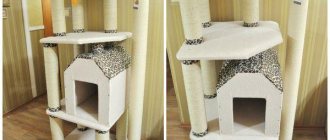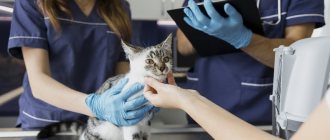Ear discharge is a symptom characterized by the appearance of fluid or a similar substance from the external auditory canal. What does brown discharge from the ear indicate?
Author:
- Sadykhov Rahim Agalarovich
ENT pathology expert
3.67 (Votes: 6)
Ear discharge is a symptom characterized by the appearance of fluid or a similar substance from the external auditory canal. This may be a physiological (natural) process, but in most cases this situation indicates the development of diseases of the auditory system. Any discharge from the ears requires contacting an otolaryngologist to determine the main pathogenetic factor that caused the problem and prescribe adequate therapy.
Discharge from the external auditory canal comes in different colors. In this article we will look at what brown discharge from the ear may indicate.
The structure of a cat's hearing organs
Like a human, the animal's ear consists of 3 sections:
- External department. It is a funnel-shaped auricle, covered from the inside with a small number of guard hairs. The outside surface is covered with wool. There is an external auditory canal.
- Middle department. It consists of an eardrum and a bony tympanic cavity, within which there are 3 auditory ossicles, which play a decisive role in the perception of sounds.
- Internal department. It is a hollow bone formation located in the temporal bone. This is the most difficult department. It also contains channels of the vestibular apparatus and receptor channels of hearing.
An important feature is the curving ear canal, which runs at an angle. In humans it is straight and short. Without knowledge of the true structure of the animal's ear, there is a risk of creating a plug of wax that blocks the passage, provokes deafness and causes headaches, nausea and vomiting in cats.
When to use ear drops that soften wax deposits?
In veterinary pharmacies, among the cat ear care products there are also drops, the use of which makes the procedure easier, since the drugs soften hardened wax deposits.
When should they be used? Many pet owners instill the drug before starting the ear cleaning procedure. However, this is not necessary. Moreover, preliminary instillation can force the animal to intensively scratch its ears, since the softening of the wax plug is accompanied by itching.
It is more advisable to use droplets directly during the cleaning procedure. The drug should be instilled after the previously cleaned ear is folded back. While the owner removes dirt from the convolutions of the sink, the droplets will work, and the process of cleaning the channel will be much easier. Manipulations carried out by humans will relieve the cat’s desire to scratch his ear, which accompanies the action of the drops.
How does wax form in cats' ears?
Sulfur production is a natural process. Ear secretions produce earwax for several reasons:
- To lubricate and moisturize the skin in the auricle;
- To protect against bacteria entering the ears;
- To prevent the spread of fungi;
- To protect against the entry of foreign objects: dust, insects and other debris.
Basically, debris that enters the ear clumps in the wax and is eliminated from the body naturally. In healthy cats, sulfur has a paste-like consistency, is brown in color, and has no odor. If sulfur begins to acquire a pungent odor and changes color and consistency, this may indicate the onset of a disease.
What causes ear contamination?
Accumulations of earwax are dangerous not only because they cause various pathogenic health disorders and cause a decrease in hearing acuity.
Accumulations of sulfur create a favorable environment for the activity of pathogenic bacteria and fungi. They often become the cause of various local inflammatory processes and contribute to the development of otitis media.
Also, cats whose owners do not consider it necessary to clean their hearing organs are more susceptible to parasitic diseases; they are much more likely to become victims of ear mites, that is, they become infected with otodectosis.
How often cats' ears are cleaned
Are cats' ears cleaned if they have natural wax? The answer is no. If the cat is domestic, and sulfur is produced in optimal quantities, then the sulfur should not be touched often. Otherwise, sulfur will begin to be produced in abnormally large quantities, which will cause traffic jams.
Then how often should you clean your cat's ears? The frequency of cleaning depends on the following factors:
- Cat breed. Sulfur is produced in large quantities in breeds with large ears, such as the Savannah and Somali, and in hairless breeds, such as the Sphynx and Peterbald.
- Health status. Increased sulfur production, its absence, as well as its atypical state can be directly related to the unstable state of the cat's health. In such cases, it is necessary to consult a veterinary clinic.
- Lifestyle. In active cats that have access to the street and live in unfavorable conditions, the risk of foreign objects getting into the auricle increases significantly.
- Age-related changes and characteristics of metabolism in the body.
Why are dirty ears dangerous for a cat?
Timely ear cleaning is necessary for absolutely all pets, both high-breed and simple, “yard” pets. Why is its absence dangerous? First of all, the fact that sulfur accumulates in the canals of the hearing organs. This is inevitable, since this substance is produced as a kind of protection from environmental influences - loud sounds, constant “white” noise, dust and street dirt.
Over time, the accumulated wax hardens and turns into a plug that completely blocks the ear canal. When this happens, the animal begins to show anxiety, shake its head, constantly fiddle with its ears with its paws, and scratch them. And this, in turn, often leads to mechanical damage to the ears.
The wax plug itself not only causes discomfort to the cat. It becomes the culprit of decreased hearing acuity and changes in intracranial pressure. It is precisely because of the compacted accumulations of wax in the ears of cats that they often feel sick, they experience intestinal dysfunction and many other pathogenic conditions that, at first glance, cannot have a direct relationship to the cleanliness of the hearing organs.
Preparing to clean your ears
Before cleaning your ears, it is extremely important to inspect your ears. To do this, you just need to carefully turn it inside out and inspect it. If sulfur is present in large quantities, then purification is necessary.
It is not necessary to go to the veterinary clinic. You can do the cleaning yourself. You just need to prepare properly and know how to clean your cat’s ears at home.
Important steps:
- you need to trim your nails so as not to accidentally hurt your pet during the cleaning process;
- buy a treat that will distract attention;
- calm down and do not raise your voice at the cat, do not make sudden movements and touch the pet carefully;
- gently wrap the cat in a soft blanket or towel to block unnecessary movements and prevent scratches.
Next comes the stage of selecting items to clean. What you can use to clean cats’ ears must be purchased and prepared in advance:
- Cotton pads;
- Cotton swabs (for external cleaning only);
- Sterile bandage;
- A bottle with a suitable lotion or drops. The following products are especially good: Bars, Euracon Pharma Otoklin, Beaphar and Excel Ear Cleansing. If for some reason you were unable to purchase lotion, then Chlorhexidine and Miramistin can be excellent alternatives for cleaning your ears. Colognes, iodine and hydrogen peroxide, which some owners manage to use, are contraindicated for cleaning. Yes, these products do a good job of cleaning wax from the ear, but they also injure the skin and contribute to more intense wax production in the cat’s ears.
There are various powders and powders, but they should never be used for cleaning. These products mix with sulfur formations and form plugs;
What special products should you use when cleaning cat ears?
The choice of ready-made special products designed to keep cat ears clean is quite large. Manufacturers of pet products offer not only lotions or disinfectant solutions, but also gels, drops, and oils that can carefully “dissolve” sulfur deposits, soften them and simplify the cleaning procedure. Wet wipes for cleaning the hearing organs of animals are also available in veterinary pharmacies and pet stores.
Which ear lotion for cats should you choose? Among the pet products produced by domestic manufacturers, the following brands have proven themselves well:
- "Dewdrop".
- "Leopard".
- "Otoklin".
If the animal owner wants to use imported ear lotion, the following are suitable for cats:
- Leo Cat Cleaner.
- Otifree.
The entire Hartz product line is famous for its good reviews from pet owners.
Ear Examination Flashlight
How to clean it step by step
- Relaxed state. Cleaning is easy to do while the cat is sleepy and calm.
- Blocking movements. To prevent the owner from injuring the cat, and also to prevent the cat from injuring the owner, it is necessary to fix the cat’s position in a soft blanket, sheet or towel.
- Extremely careful turning the ears outward and inspecting them for dirt using a flashlight.
- If there is an abundance of plaque, the ears are treated with appropriate drops and lotions.
- Cleaning is carried out using the “inside-out” method, removing all the dirt in the ear canals. Dirty cotton pads or sterile bandages are replaced with clean ones until the canals are completely clean.
- Using cotton swabs dipped in lotion, the outer folds and skin are thoroughly processed.
- Once cleaning is completed, the pet is released and given a treat as a reward. This helps to introduce your pet to ear cleaning in the future.
For detailed instructions on cleaning cats' ears, watch the video on cleaning a cat's ears.
Otodectosis or ear mites
Otodectes (ear mites) is a common parasitic disease caused by the Otodectes cynotis mite. Mites infect the inner surface of the cat's ear, ear canal, and even the eardrum. In advanced forms of otodectosis, parasites invade the meninges, causing disturbances in the central nervous system.
Symptoms of the disease:
- the cat shakes its head, crusts and dirt fly out of its ears;
- an abundant dark brown or black wax deposit forms in the animal’s ears (this plaque is similar in structure to instant coffee);
- lethargy, increased body temperature in the cat, and bowed head may be observed;
- in advanced stages of the disease, the eardrum bursts, and the cat develops neuralgic disorders (fits, convulsions).
Otodectosis has pronounced symptoms, but the final diagnosis can be made by a veterinarian after testing for the presence of ear mites.
Treatment for ear mites in cats
Otodectosis therapy consists of three main measures:
- mechanical cleaning of the ears;
- use of acaricidal drugs;
- strengthening the cat's immunity.
The purpose of mechanical ear cleaning is to remove mites, their eggs and waste products, remove crusts and wax deposits from the ear canal. For this procedure, you need to use disinfectant solutions - furatsilin solution or 3% hydrogen peroxide. To more effectively clean the ear from parasites, it is recommended to use an acaricidal drug, acaromectin, in combination with disinfectants.
After cleaning the cat’s ears from mites and dirt, the ear canal is treated with acaricidal drugs - acaromectin, otoferanol or stronghode. To distribute the medication evenly, gently massage the cat's ears.
To strengthen the cat’s immunity, immunomodulators and vitamin therapy are used:
- ribotan;
- immunofan;
- gamavit;
- mineral and vitamin complexes.
When treating ear mites in a cat, it is necessary to carry out a complete disinfection of the house:
- wash and treat the animal’s bed, rugs and toys with disinfectants;
- Do wet cleaning with disinfectant solutions every day.
If you have several pets, then they also need to be shown to a veterinarian and prevent the disease. After the cat is treated for otodectosis, the veterinarian conducts a repeat test for the presence of parasites. Only if the test result is negative, the cat is considered healthy.
Prevention of otodectosis
Any disease is easier to prevent than to treat. Ear mites in cats are no exception. To prevent otodectosis it is necessary:
- regularly inspect the animal’s ears and clean them if necessary;
- treat the cat with antiparasitic agents in a timely manner;
- observe the rules of hygiene and cleaning of premises;
- Provide the cat with proper nutrition and proper care.
If you find one of the symptoms of otodectosis in your ward, immediately contact your veterinarian to diagnose the disease and prescribe treatment.
